A year ago, my friend and former blog partner Joe (a.k.a. J-Unit) had a bachelor party up in Lake Tahoe. It was a pretty fun bro weekend full of beer pong, barbecuing, and a forest fire (unrelated to the barbecuing). With the area full of smoke, we spent a lot of time indoors, and thankfully our friend Isaac had brought a game. Specifically, Settlers of Catan. It was the first time I had even heard of this cultural phenomenon, and I can assure you that after my first play, my life was changed — CHANGED, I TELL YOU. Catan blew my mind, and being that I’m a curious type, I spent the next several weeks devouring any sort of media about it that I could find (videos, articles, performance art, anything). I soon discovered that Settlers of Catan was only the tip of the gaming iceberg. There were many, many, many more modern board games out in the world, and they were a far cry from the roll-and-move games of our youth.
A year later, I’ve slid down the rabbit hole and found myself fully obsessed with modern board games. I suppose it shouldn’t be a surprise: I’ve been a video game fanatic for years; so board games are a logical next step in my playtime activities. Nevertheless, one of my great weaknesses is forcing my obsessions onto innocent bystanders, and subsequently, I now talk everyone’s ear off about tabletop gaming, often hijacking my podcasts to extol the virtues of Catan or Dead of Winter.
The response has actually been pretty cool. I receive several Tweets and messages asking for recommendations, and who am I to deny ANYONE my thoughtful opinion? I’m not a monster, after all. I AM AN INFLUENCER, DAMMIT. (Somewhere there is a Klout score to verify this, as well as several free shaving kits, some Hulu vouchers, and an Audi).
That being said, after the jump, check out an unsolicited tour of my gaming collection. Hopefully you’ll find something in there that will inspire you to either dive into the hobby or expand your collection. At the very least, it’s a fun way to pass five minutes on the Internet.
Must Haves: The best of the best.
Catan
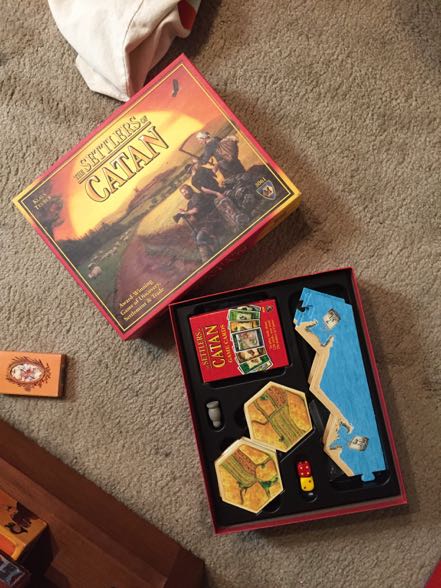
Catan receives the greatest honor of all: a photo shoot on my dirty carpet.

Gazing upon Downtown Los Angeles, which took perhaps more than three rocks and two wheats to build.
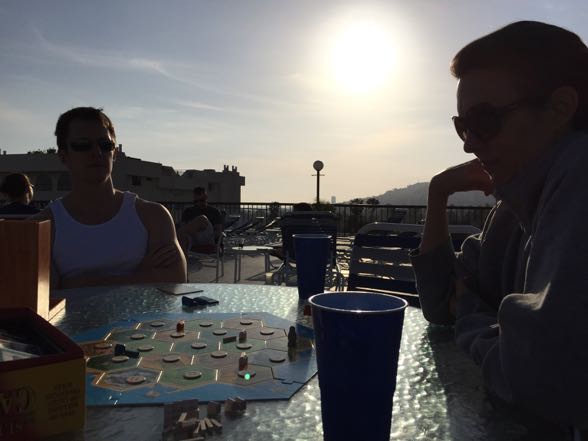
My friend m_ruv brings a new resource to the island of Catan: GUNZ.
This is the game that hooked me in, and it’s the one that’s been played the most with my friends. It’s a modern classic, and it continues to be a total blast to play. The secret is the player interaction: in order to win the game, players must trade with each other, potentially helping their opponents in their race to victory. The seamless integration of negotiation with bluffing, area control, resource management, dice rolling, secret information, and variable setup is unparalleled. Other games arguably have refined these mechanics, but few, if any, balance them all in such an elegant way.
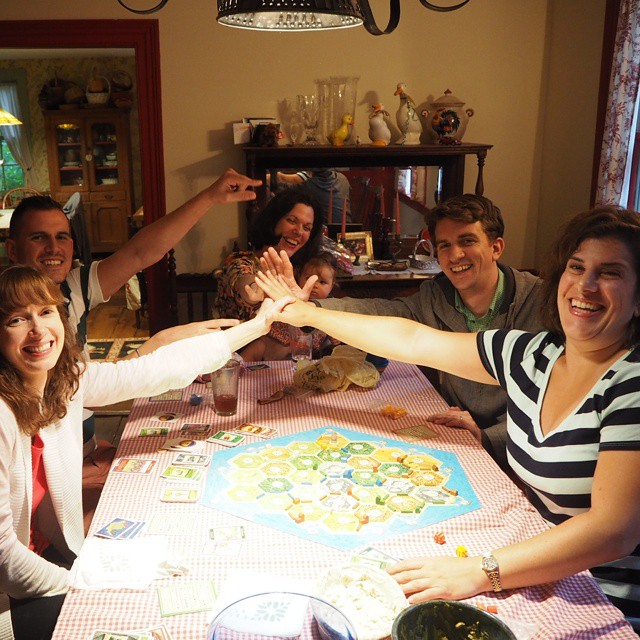
Are these the faces of people having a bad time?
EVEN THE BABY LIKES IT.
Catan is exciting, highly social, and pure fun. Even though these days I’m interested in playing other games instead, that’s less a reflection of Catan and more about exploring other gaming experiences. I still love Catan, and I always have a fantastic time playing it. Why do I sound like I’m breaking up with someone?
More so than any other game on this list, this one must be in your collection. Plus, look how photogenic it is:
No gaming snobbery here. I love Catan!
Dead of Winter
If you told me one of my favorite board games of all time centered around a zombie apocalypse, I’d think you were smoking crack. But guess what? You’re not smoking crack! And I still love this game. Dead of Winter is a semi-cooperative game that has never failed in eliciting a tense, hilarious, and super memorable evening. Thanks to the colorful characters involved and the potential for a traitor to lurk at the table, every playthrough becomes its own unique story. Some nights, we all wind up yelling at each other (in fun). Other nights, we’re cringing as zombies attack the town ninja (also in fun).
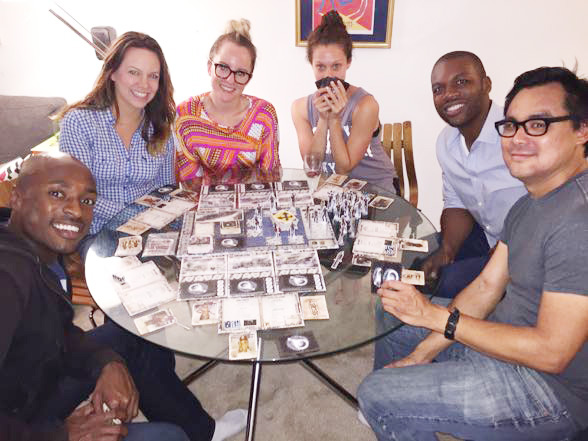
We managed to play Dead of Winter with seven people (including me, behind the camera). It worked!
By the time Dead of Winter draws to a close, everyone feels like they’ve just spent a great night at the movies, with adrenaline-tinged chatter reliving the most exciting and hilarious moments. This is not a game about strategy. This is a game about creating a social experience — one that you’ll be talking about for months after. For reals. Even if you don’t like zombies, even if you don’t like horror, even if you don’t like board games, get it get it get it.
Concordia

Terrible box. Great Halloween costume.
This is the most cerebral game in my collection, and one of my all-time favorites. Gameplay centers around developing cities around Europe and currying favor with Roman Gods — as one does. It’s reminiscent of Catan (erecting buildings, gathering resources), but Concordia is its own fantastic beast. The game is all about timing: when to build, when to purchase, when to expand, when to collect. Every turn grows increasingly tense, especially because at every turn the game seems to be conspiring against you: Want to buy a new card? You’ll need a brick first. Want a brick? You’ll have to buy it. Want to buy a brick? You’ll need cash. Want to earn some cash? Play the Colonist card. Want to play the Colonist card? Too bad. You already did two turns ago, YOU IDIOT. Time to reset the deck, get the cash, buy the brick, and finally grab that new card! Too bad though. Someone else just bought it. UGHGGHGHGH I HATE YOU I LOVE YOU, CONCORDIA. [the mere fact that I’m having a tantrum over little wooden bricks indicates how geeky I have become].
Unlike Dead of Winter, there’s no storytelling involved, but each game ends with the same blathering of excitement as players explain their strategies and try to pinpoint where things went wrong (or right). It’s hard not to pick up the pieces and start a new round right then and there. The more I’ve played Concordia, the more I’ve come to appreciate how utterly awesome it is. My friend Derya has declared it her favorite game of all, even higher than Catan. So, there’s that too.
Top Tier:
I love these games and am always eager to get them onto the table.
Viticulture & Tuscany

Any game that inspires wine consumption is just fine with me.
A wide swath of board games focus on fantasy creatures and magic spells and sci-fi mumbo-jumbo, which is totally cool, man, but a game about elven knights exploring a dungeon on Mars doesn’t always align with the tastes of my usual gaming friends (although, I would totally play it). Thankfully, we have Viticulture, a perfectly civilized game about the fine art of winemaking. This foray into 19th century Tuscany allows players to partake in all sorts of bucolic activities: planting vines, harvesting vines, crushing grapes, aging wine, and selling orders of your beautifully manufactured product. Additionally, players may build tasting rooms, give tours, welcome visitors, and do all those wonderful things that any self-respecting oenophile would dream of. Basically, this is the Nancy Meyers movie of board games.
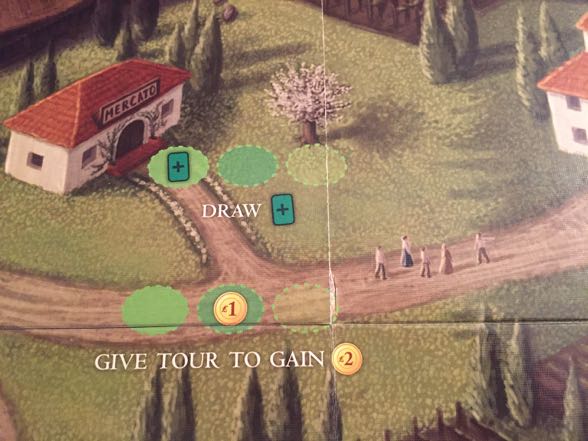
Look at the little people. They’re going on a tour! I HAVE SUCH FOMO.

It’s so serene. I want to reverse Jumanji myself into this game.
Everything in Viticulture all sounds positively lovely, and yet the gameplay is tense, tight, and occasionally ferocious. We like that. It’s a really fun game and great for people whose fantasy worlds look more like Napa than Middle Earth. But wait, there’s something you need to know. While Viticulture is fun, the game’s expansion Tuscany is an essential purchase. It’s an investment — Tuscany costs more than the original game — but well worth it. The new gameplay modules open up Viticulture, taking it from here [my hand is near my chest] to HERE [over my head]. The permutations of gameplay and strategy are seemingly endless. One simply must invest in Tuscany. I mean, imagine It’s Complicated without Meryl Streep. No reason to see it! Tuscany is Meryl Streep: undeniable.
Survive: Escape from Atlantis!
Those looking for a highly engaging, highly social, and highly hilarious board game should look no further than this thirty-year-old title. Survive plays out like a reality show: tenuous alliances form, backstabbing ensues, and eventually the whole thing ends when a volcano erupts. Admittedly, the volcano gimmick hasn’t really been explored on the likes of Survivor or Big Brother, but it should be! IT SHOULD BE.
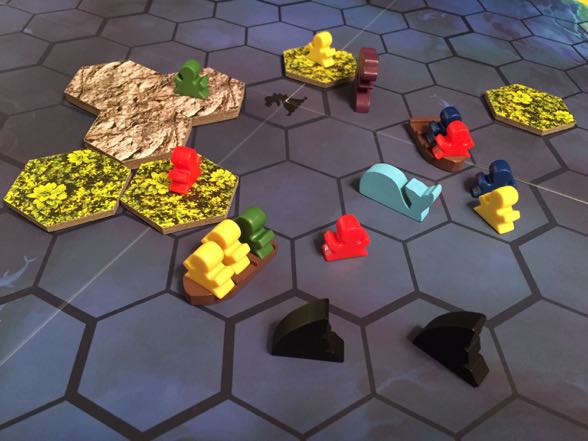
Drama in the high seas: sharks circle the red guy while a purple sea monster seems poised to eat a nearby lifeboat. Fun!
The long and the short of this game is that players all control about ten little dudes (or dudettes) who need to flee the sinking island of Atlantis. On their trek to safety, many will perish thanks to sharks, sea-monsters, or an ill-timed whirlpool. It’s a pretty straightforward game, but there are secretly many layers of strategy in both how players move their characters on the board and how they interact with each other above the board. Be the aggressor, and the group will turn against you. BUT offer a helping hand, and… the group will still turn against you. Listen, that’s life. Survive: Atlantis is an excellent game for any group (kids to adults), and it will surely elicit peals of laughter while simultaneously revealing all sorts of fascinating social dynamics about your friends. Don’t be surprised when your bestie pulls away in a mostly empty boat, leaving you to float off into the abyss Jack Dawson style.
(Oh, and PS as an added bonus, the publisher, Stronghold Games, is super responsive to customers. I lost a meeple, and they mailed me out a replacement free of charge. We love that.)
Isle of Skye
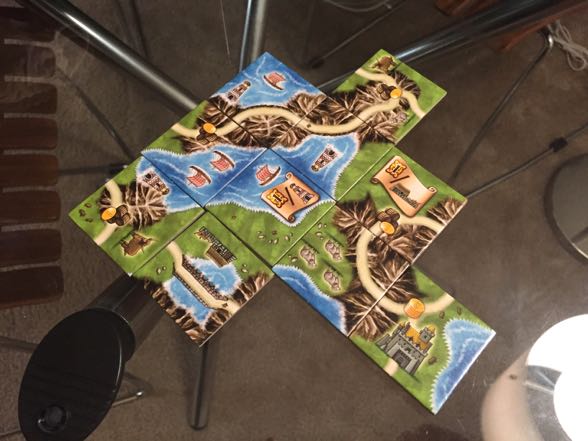
A typical landscape in Isle of Skye
This game. THIS GAME. I fell in love with it the first time I played it. Isle of Skye has players creating their own little Scottish landscapes, which has always been a life goal of mine. This is achieved by purchasing tiles, which in turn are priced by your opponents. Of course, you can price tiles for your opponents too, which leads to a rowdy marketplace of speculation, overpaying, and general mayhem. I won’t get into the mechanics of it all, but trust that it’s actually genius. Once you’ve managed to acquire a tile or two, it’s time to place them together as smartly as possible. That’s because every round doles out points to players who form certain features in their terrain: mountain ranges, roads, or whiskey barrels for example. Different rounds reward different things — mountains may be important early on, but that whiskey situation is what you really have to keep your eye on later in the game. The goals become nicely enmeshed, and if there’s only one lighthouse on the table, and it’s about to score for the next three rounds, you can bet than the marketplace phase is going to get all sorts of wild.
SO. FUN.
One caveat: I’ve played with just two players, and it’s perfectly lovely, but the real thrill comes from a full table.
Village

Just another cheerful day in the village square: a priest marries a young couple, two gentlemen wave hello at the steps of Town Hall, and a farmer delivers hay to the locals.
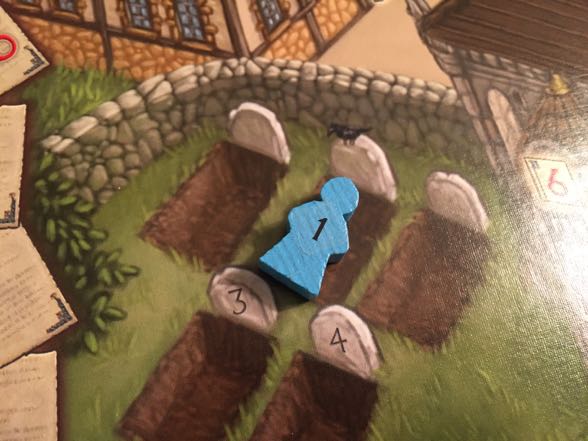
Meanwhile, this guy is DEAD in an unmarked grave, and the only one who’s ever bothered to visit him is the tiny crow on his tombstone.
Village is a charming game set in — you guessed it — a village! A Medieval German village, to be specific. Players all control a different family in town, guiding them through the ins and outs of The Olden Days. There’s much to do in the village: become a wainwright, rear horses and oxen, sell goods at the market, join the village council, travel the countryside, have babies, tend to the farm, join the church, OR GET THE BLACK PLAGUE AND DIE.
Yes, as sweet and lovely as Village seems to be, this game is about cold, hard death. Your dear meeples (that’s what you call wooden people in games) can only fend off the march of time for so long, and inevitably, that tireless scroll-writer will kick the bucket, forever to be enshrined in the village chronicle (or an unmarked grave). That’s right — nearly every action in this game takes “time,” and when enough time passes, someone keels over. It’s grim, intriguing, and totally fun. More importantly, the births and deaths give Village a narrative arc, inspiring players around the table to weave poetic (read: not poetic at all) tales about their meeples and their terrible fates. It’s a layer of storytelling and immersion that not many games in this genre (known as worker-placement or action-drafting) have. It doesn’t hurt that the gameplay is richly rewarding and fun. Things start out pleasantly, but by the end, y’all are clamoring for every tiny action. Beware the death-grip of Village!
La Granja
This is one of my newer games. The first time I played it was against only one other person, and the experience was aiiight. A few nights later I partook in a three person game instead, and HOLY SHIT THIS GAME IS FUN. The elevator pitch: you play farmers in Majorca, Spain trying to improve your prestige by developing your homestead and selling things like grapes and pigs.
Admit it: you’re hooked.
At this point, you may think I’m crazy. I’ve already endorsed a game about winemaking, a game about dying in a village, and a game about the Scottish landscape. Clearly, I have some agricultural yearnings, despite living in the heart of Los Angeles. Nevertheless, La Granja is another rural escapade, and it’s so so so so fun. SO fun. There are also a million rules and phases and steps, which makes it a pain in the ass to teach, but the truth is that it actually all flows together effortlessly, and despite all the mental uploading, it’s really not that hard to learn.
In a nutshell, players play cards to either add fields, pig stables, helpers, or market barrows to their farms. They then receive income, grow produce, breed pigs, and then build roofs on their farmhouses. After that, we roll dice and take revenue — perhaps in the form of some grapes or perhaps a donkey. You see, donkeys allow you to deliver things to town, and the more donkeys the better. Of course you can always choose to nap instead of deliver, but then your market stall in town might get bumped by your opponent’s bigger, shinier stall. Then again, the more you nap, the more likely you’ll get to go first in the turn order. Also, don’t forget that the butcher needs pigs, the bank needs money, and about four other places in town require something or another from you. After that, rinse and repeat five more times. Makes sense, right?
Okay, maybe not. Just trust the process, follow the player aid, and give yourself over to La Granja‘s glory. The game has many paths to victory, and part of the fun is figuring out how the hell you’re going to develop a strategy that maximizes your farm’s unique qualities. La Granja is meaty, interactive, and prone to some great post-game analysis.
Very Fun, Worth Having:
These games are super fun, but I’m not always reaching for them first. They will not disappoint though.
K2

Behold the majesty!
I don’t get to play K2 that often, but when I do, I’m always reminded of how fun it is. Basically, you send your two climbers up the fabled mountain of K2, and if you’re lucky, they survive. If you’re unlucky, they succumb to bad weather, lack of oxygen, and hostile terrain. In other words, they die. Funny how death in board games leads to such great entertainment. Protip: when playing K2, be sure to name your climbers. It injects the game with a huge amount of personality, especially if you use celebrities. My first playthrough had me overseeing the expedition of Kim Richards and Robin Roberts.
Lords of Vegas

It’s only fitting that a game about Vegas has a garish board. (It’s actually really cool in person)

Dice! And chips! Admittedly, the chips don’t come with the game. I just bought some cheap ones for the fun of it.
This is another feisty game that often leads to dramatic swings of fortune, much in the spirit of Las Vegas itself. Players take on the role of real estate developers in the ’40s, erecting casinos on the nascent Vegas Strip. There’s wheeling and dealing and even a little gambling, leading to hostile takeovers and power grabs. You’ll find yourself jockeying for position, throwing down sums of cash to regain influence in the casino your best friend just stole from you. It’s raucous and dramatic and a great addition for people looking for some push-your-luck dice action.
Pandemic
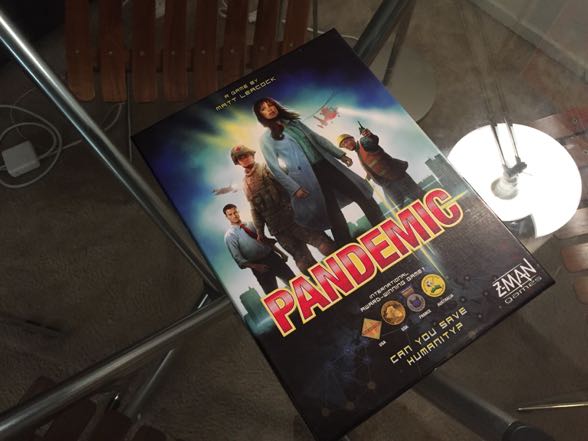
Starring the cast of Code Black.
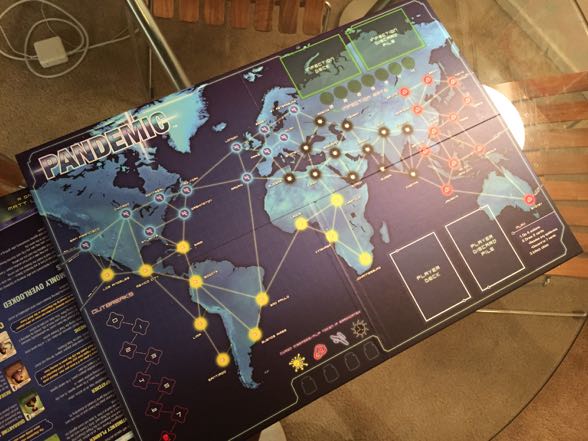
This board is SICK. (pause for laughs)
Pandemic is turning into a modern classic (I mean, it’s sold at Target for crying out loud), and as cooperative games go, it’s pretty much the reigning king. Players all work together to stop the spread of various diseases, viruses, and plagues as they inevitably take over the world. Draws from card decks ensure that disaster is always a breath away, but careful planning and coordination can lead to a well-earned, adrenaline-fueled victory! Probably not though. This tense, super-fun game almost always ends in an apocalypse. But hey, it’s a lovely way to relive the Ebola crisis of 2014!
Bruges

Note the despondent Glassblower and the scowling Poet. Typical tortured artists. They could learn a thing or two from the maid, who’s still smiling, even after cleaning up everyone’s filth.
I’ve only played Bruges once so far, but it was a quick, punishing game that feels akin to fixing a plane while it’s trying to take off. Nothing goes as planned, and making quick tactical changes is part of the challenge. The long and the short of it is that players are balancing about ten different problems all at once: building canals, housing residents, gaining influence, reducing threats, hiring workers, earning money, and just trying to live the dream, brah. Naturally, this all occurs in Medieval Bruges. Despite all these bonkers things going on and despite my opponent and I having wildly divergent strategies, our final scores differed by only one point. Pretty cool. I’m looking forward to further adventures in Bruges, if only to afford my non-gaming friends the opportunity to mock me for having a board game that takes place in Bruges. IT’S FUN, AND I WILL NOT FEEL SHAME.
Coup
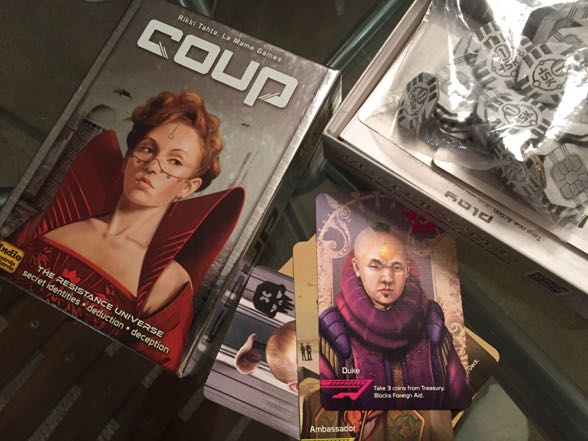
Both a game AND a future Project Runway episode.
Not so much a board game as a small card game, Coup has people bluffing their way around the table in a fast, surprisingly intense battle of mental chicken. It’s like Bullshit! but with special powers. Every action has players accruing money or spending it, all in the hopes of “killing” opponents. That’s fun, right? Tension ramps up quickly — like, within 3 seconds — and the rounds last not much longer (typically three to five minutes). It’s quick, dirty, and a blast. And for $10, it’s the easiest purchase on this entire list.
Pictomania

This dragon is having a great time, despite the fact that his universe is collapsing into itself in a vortex of time and space.

Just try to draw one of these clues. Try.
Ooooh — a party game! Sort of. Pictomania is like Pictionary on crack. Instead of one person drawing and a bunch of people yelling (which, admittedly, is always fun), Pictomania has EVERYONE drawing and EVERYONE guessing all at once. As you can imagine, it’s a bit hectic. There are about ten more devilish facets too that I won’t get into, but needless to say, this has left my friends and I clutching our guts with laughter. The harder the clues, the funnier the game. My only complaint: the game accommodates only six people, which unfortunately makes this party game too restrictive for big groups. Bummer.
A Fake Artist Goes To New York

Big laughs come in small boxes.
Yes, that is the actual title of this Japanese game, and yes, this is another party/drawing game. Unlike Pictomania, A Fake Artist Goes To New York accommodates up to ten people, perhaps more with some creative finagling. The premise is simple: a pad goes around a circle, and everyone draws part of a communal picture. Everyone knows what they’re drawing except one person, who has no idea. It’s up to the group to figure out who the clueless bastard is, and it’s up to the clueless bastard (a.k.a. the Fake Artist) to figure out the drawing. This creates a brilliant dilemma: if a “real” artist contributes to the drawing too well, the Fake Artist will catch on. But — but — if the real artist tries too hard to throw off the Fake Artist, it’s likely that everyone else will be so confused that they’ll accuse the real artist of being the clueless fake artist. Are you following this? I hope so because this game is a RIOT. Oh, and just wait until you’re the Fake Artist. The amount of panic you’ll experience is ridiculous. During one recent game, the group drew Point Break, which I naturally interpreted as Independence Day. Needless to say, I easily outed myself when I drew a giant spaceship over Johnny Utah.
The good news is that anyone can play this game at home with a few pieces of paper and some pens (all of unique colors so people’s contributions can be differentiated). However, I bought the official game because I like the little pens and the tiny pad (the smaller the canvas, the more hilariously confusing the the drawing becomes). Belly laughs, people. BELLY LAUGHS.
Mysterium / Tajemnicze Domostwo
Riding the line between party game and regular game is Tajemnicze Domostwo, which was originally a Ukrainian game and underwent several international iterations until finally coming to American this fall under the name Mysterium. The premise is goofy and simple: one player is a silent ghost, the others are psychics brought to a mansion to investigate the ghost’s untimely death. Every night, the ghost sends out dreams in the form of abstract images on cards, and using those cards, the psychics must determine the who, the what, and the where of the murder. It’s like Dixit meets Clue.

Somehow this creepy scarecrow is supposed to point to one of these three suspects.
The fact that whoever plays the ghost cannot communicate is hilariously frustrating. It’s a helpless feeling, watching the psychics erroneously dissect the card you just gave them. I might hand over a bizarre image of a rat in a top hat, and one person immediately thinks this is CLEARLY an allusion to the rat-faced suspect on that side of the table. Another thinks the top hat is just the sort of formal accessory that the fancy suspect over THERE would wear instead. They’re both wrong. The rat’s gray color is supposed to reference the gray color of the lady in the corner who… ugh. Forget it. WHY EVEN TRY TO COMMUNICATE WITH YOU MORONS??? Yup, it’s a total clusterfuck of perception and deduction in the most entertaining way. However, I like to play Myserium sparingly, lest the thrill of it all get old too quickly.
These Are Fun, But They Require The Right Group
These games are all worth investigating, but several of them need the right kind of players: in some cases, people who are down for a long game (Nations) or in other cases, people who can bring color to an otherwise dry or solitary experience (Suburbia or Roll for the Galaxy).
Nations
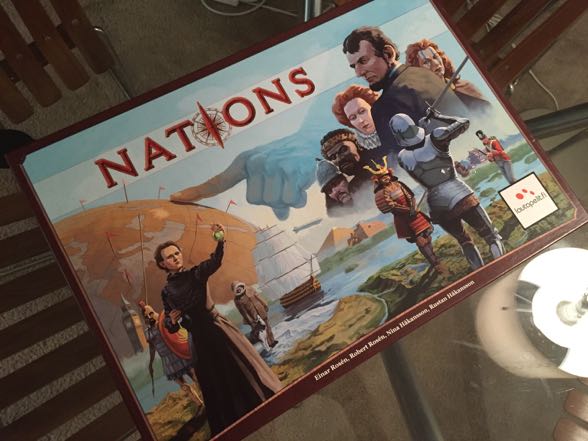
Historical figures, UNITE!
I actually love Nations, but I rarely play it. Why? Because this game takes forever. The first time I ever played, it took five and a half hours. Online reviewers said the game would only take a mere two hours or so. This was incorrect. It was long. I mean, it was a brisk, fun, and highly engaging five and a half hours, but five and a half hours all the same. I’m hopeful that in future playthroughs, Nations won’t take as long, but for now, it’s been relegated to afternoons, and unfortunately it’s not always easy to lock people down on a beautiful Saturday afternoon here in LA for a five and a half hour game.

Behold the steely grit of MARIE CURIE!
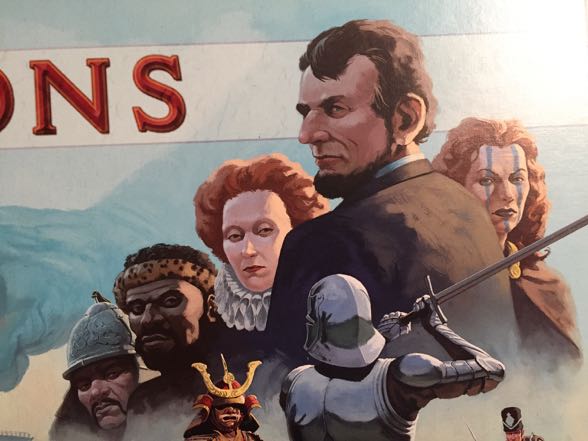
It’s like the historical version of I Know What You Did Last Summer.
That being said, Nations is a gloriously evil game. Players are charged with developing a civilization from Antiquity through the Industrial Revolution, which sounds benign enough, but at no time whatsoever are there enough resources or actions to do all the things you want to do. It’s an agonizing game of priorities, decisions, and failures. So many failures. But windfalls of success too! An emotional roller coaster, fit for any group of people looking for an epic gaming experience.
The Resistance
A unique take on the classic Mafia party game, The Resistance has players assuming the roles of good guys and bad guys, with the bad guys pretending to be good guys long enough to destroy everyone’s plans. It’s up to the group to route out the traitors before it’s too late. Sounds pretty standard, right? Well, it is. Where The Resistance differs is that it offers a variety of mechanics so that no one is eliminated and no one has to step out of the action in order to lead the activity. It’s a great way to keep an entire room involved the whole game. However, the thing about party games is that people usually want to jump into them right away. No one wants rules, and The Resistance has just enough to turn off people. In my experience, once one or two people’s eyes glaze over, it’s hard to win back the room, especially if people actively protest against the game for being too confusing, even if it’s really pretty straightforward.
The thing is, if you can get a group patient enough to learn the The Resistance‘s extra two minutes of rules, the game can be an excellent party game. It’s loud, funny, and full of dramatic reveals. But that’s only if people are down for the cause. Otherwise, you better just stick to Mafia and Celebrity. (Also, The Resistance only accommodates ten people. Not sure if expansions fix that or not).
Once Upon A Time

DIY fairy tales.
The idea behind this card game is simple: everyone has a card with the ending of a fairy tale (ie. “And they lived happily ever after” or “So the village was restored to prosperity.”). Players then receive about six or seven cards with words or concepts on them (witch, prince, afraid, e.g.). Over the course of the game, the group tells a communal fairy tale, incorporating words from their hand into the story. Players discard the cards as they use them, ideally steering the fairy tale towards the happy (or unhappy) ending in their hands, which they eventually play when no other cards remain. But here’s the catch: should you happen to mention a word in someone else’s hand, they can take over the story — and you take on a new card as a penalty. First person to discard all their cards, including their ending, wins.
When I first saw this game played on the Wil Wheaton web series Tabletop, I was sold. I loved the blend of creativity with gameplay, and soon I had ordered my very own copy of the game. It has since provided some of the most memorable gaming moments of the past year. But I’ve learned the hard way that it’s not a guaranteed hit. You see, Once Upon a Time requires buy-in. People need to want to tell a story more than they want to win. The best sessions have been long, laugh-so-hard-you-cry tales with highlights so vivid that my friends still quote them months later. The worst sessions have seen people so concerned with getting rid of cards in their hands that they just motor through the game before a decent story has been told. No laughter, no magic, and NO MEMORIES. This is a great game, but make sure you have the right group to play it with.
Suburbia
Hey, it’s SimCity™: The Board Game! Sort of. In this game, players lay down tiles representing residential zones, industrial zones, and all those other zones we know and love from our favorite city-building games. Depending on how and where you place your tiles, different things may happen: your population may rise, your income may fall, your reputation may go berserk. Suburbia is a pretty swell game, but it can also be a dry exercise in placing buildings and counting numbers. The super drab artwork doesn’t help (seriously, it’s terrible). Nevertheless, the game is best played with social people who can inject some flavor into the bizarre cityscapes you’ll be constructing. After all, it’s pretty funny when you wind up placing a slaughterhouse next to a museum, but if no one’s there to crack a joke about it, then WHY EVEN BOTHER??
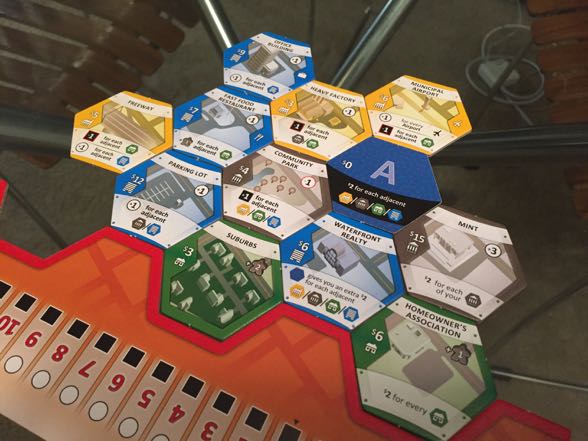
The drab color scheme of Suburbia. One cool thing: if you look closely, you can see the street grid.
Okay, of course you should still bother because it’s a fun puzzle. But what I’m really saying is that it’s up to the players to augment the storytelling in the game. The same could be said for many other titles on this list, but for some reason, Suburbia really feels like it needs the social assist. Maybe it’s because players spend so much time doting on their own little neighborhoods that the end result can be a quiet table, even during the moments of player interaction. And who wants a quiet game night? Still, the first time I played Suburbia, I fell in love with it, and I’m looking forward to getting it back on the table.
Roll for the Galaxy
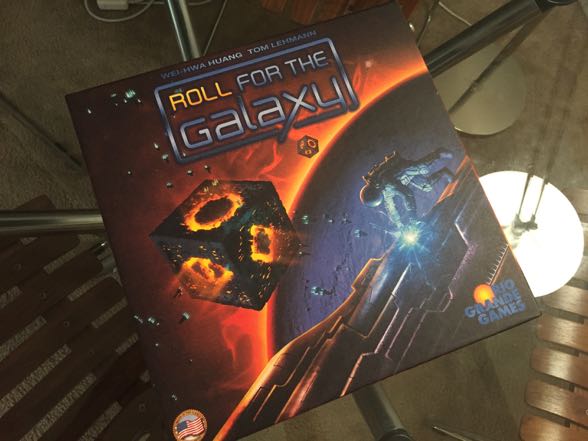
Space and whatnot.
Many reviewers call Roll for the Galaxy one of the very best games of 2014. It’s definitely cool — dice rolling and spaceships and faraway planets — but it hasn’t been a full-on hit with me yet. The rules aren’t particularly hard, but they require some brain-wrapping-around, which makes it difficult to teach to new players. Once everyone’s on the same page, the game speeds up, and it’s definitely more fun. There’s a distinct rhythm and flow to Roll for the Galaxy, and as you roll your dice and gain wealth and resources, you’ll be expanding your intergalactic empire in unique and symbiotic ways. It’s cool. It really is.

I can’t help but feel like this is the narrative arc of Real Housewives of Beverly Hills.
The problem is that the player interaction is not as high as I would like it to be. Sure, there’s some business about choosing actions — sometimes you’ll need an opponent to perform an action so you can do it too, and if they don’t do it, you’re screwed — but aside from that, it’s a fairly solitary experience. Players don’t even take turns. Everything all just happens all at once. Of course, that may be the interaction in and of itself. The game is a race to either “build” twelve tiles or exhaust a pile of victory points. Therefore, the interaction is as simple as keeping an eye on your foes and making sure you’re building your empire faster than they are. Okay, I get it. I understand that. Still, the game has not blown me away like it has every single other reviewer out there. That being said, I do find myself wanting to play it again and learn more of the nuances. I can’t help but feel like there are more experiences to be had, more GALAXIES TO CONQUERS! Perhaps with the right mix of people the game will be amahzing. But for now, it’s merely a cool exercise in dice mechanics.
Sheriff of Nottingham

Finally, a game about going through customs.
For people who think the best part of poker is putting on a p-p-p-p-poker face, there’s Sheriff of Nottingham. The rules are simple: players have a little wallet thing, into which they can place legal goods (green cards) or illegal goods (red cards). Both have their benefits. Every round, one player plays the titular Sheriff of Nottingham, and he or she is tasked with sussing out contraband. There are questions and interrogations and bribes and promises and deals and all sorts of crazy mind games, but ultimately, the action comes down to this: if the Sheriff decides to open your wallet and finds contraband, you have to pay a fine to the Sheriff. But if the Sheriff finds nothing but sweet, sweet legal goods, then he or she must pay YOU for the inconvenience. Pretty cool, huh? It’s all about reading each other, bluffing, and double-bluffing. I still am not sure if it’s great fun or totally exhausting.
Sheriff excels with a rowdy, possibly drunk group. It has the makings of a great party game, but guess what? It only accommodates five people. Whaaaa? There should be, like, twelve people involved. Five is so small. Even worse, if you play with only three or four, the dynamics just aren’t as interesting. This game is in sore need of a big group expansion. I suppose it wouldn’t be too hard to have people pair up into teams… in fact, I’ll try that and see how it goes.
That’s pretty much it. You’ve made it through my version of Oprah’s Favorite Things. Feel free to chime in with your opinions on these games. What games do you have? Any recommendations?


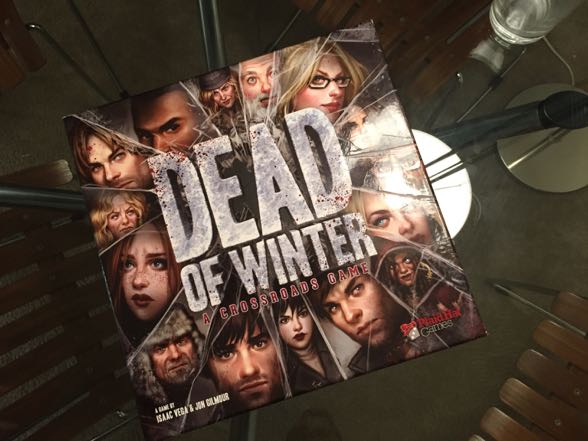
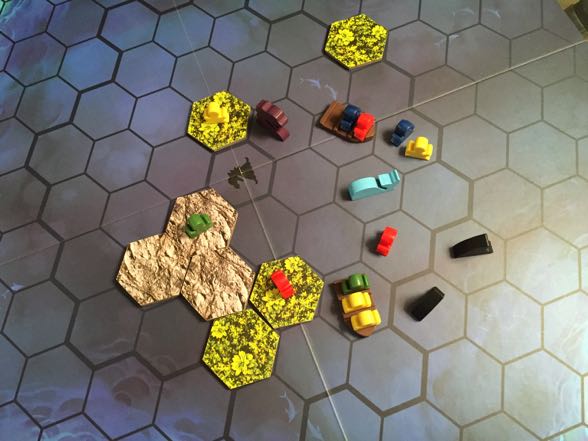


Have you played Munchkin, Fluxx, and or Hive? All great games. Hive is an awesome 2-player game. I’m also interested in trying Takenoko which I hear is fun as well.
I’ve played Fluxx and Hive, and they’re fun. Hive stresses me out a little! I played Takenoko once about a year ago. I enjoyed it, but I never really felt the need to play it again.
I’d like to try Dead of Winter, but I think my boys need another year or two (they’re 8, 10 & 11 and are quite the boardgames). Wanted to recommend Carcassonne, which is a tile-laying game similar to your photo of Isle of Sky (which, I now need to play). Carcassonne, Settlers, and Ticket to Ride are in our regular rotation along with the traditional Monopoly and Risk. Excellent blog. Thanks for all the info.
Isle of Skye is a great take on Carcassonne mechanics. I like it even better, in fact!
The greatest characteristic of a cash advance loan is
that it could be offered within a relatively small space of time — the typical payday
lender work to pay the money out within just 24 hours although some people might payday advance loan providers can offer perhaps
quicker payout times secured by warranties,
one of the fastest payday loan lenders in the united kingdom guarantees some sort of payout period of
less than 120 minutes. It’s the mix off the right
insurance policies, processes, along with controls on the appropriate layers that provide a
secure processing surroundings In fact, this
particular loan would be the ultimate economical solution for the people people
who have credit rating problems.